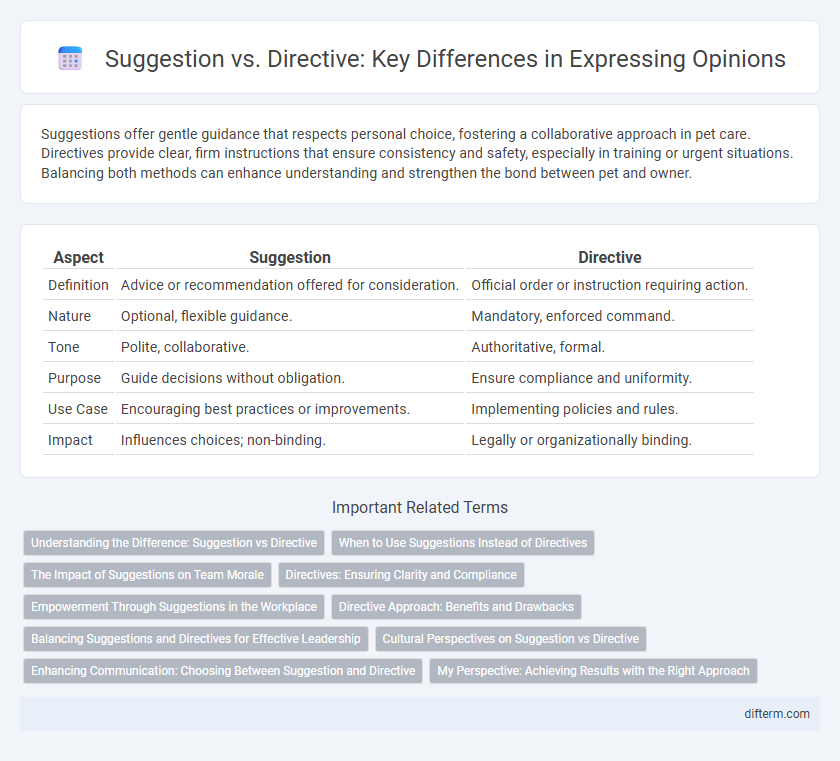Suggestions offer gentle guidance that respects personal choice, fostering a collaborative approach in pet care. Directives provide clear, firm instructions that ensure consistency and safety, especially in training or urgent situations. Balancing both methods can enhance understanding and strengthen the bond between pet and owner.
Table of Comparison
| Aspect | Suggestion | Directive |
|---|---|---|
| Definition | Advice or recommendation offered for consideration. | Official order or instruction requiring action. |
| Nature | Optional, flexible guidance. | Mandatory, enforced command. |
| Tone | Polite, collaborative. | Authoritative, formal. |
| Purpose | Guide decisions without obligation. | Ensure compliance and uniformity. |
| Use Case | Encouraging best practices or improvements. | Implementing policies and rules. |
| Impact | Influences choices; non-binding. | Legally or organizationally binding. |
Understanding the Difference: Suggestion vs Directive
A suggestion offers a flexible option for consideration, encouraging input and collaboration without imposing a specific action. A directive, by contrast, demands compliance with a clear and authoritative instruction, limiting room for negotiation or alternative approaches. Recognizing this distinction improves communication effectiveness and ensures appropriate responses in professional and personal interactions.
When to Use Suggestions Instead of Directives
Suggestions are ideal when fostering collaboration and encouraging open dialogue in decision-making processes. Using suggestions instead of directives promotes autonomy and empowers individuals to contribute ideas, enhancing creativity and buy-in. This approach is effective in environments that value flexibility, employee engagement, and innovation.
The Impact of Suggestions on Team Morale
Suggestions foster a collaborative environment that enhances team morale by valuing input and encouraging open communication. Unlike directives, suggestions empower team members, leading to increased motivation and a sense of ownership in projects. This participative approach often results in higher productivity and improved overall team dynamics.
Directives: Ensuring Clarity and Compliance
Directives establish clear expectations and foster compliance by providing unambiguous instructions that minimize misinterpretation. They are crucial in environments where adherence to procedures and standards is mandatory, ensuring consistent outcomes. By eliminating ambiguity, directives streamline decision-making processes and enhance operational efficiency.
Empowerment Through Suggestions in the Workplace
Suggestions in the workplace foster empowerment by encouraging employee autonomy and creativity, leading to higher motivation and engagement. Unlike directives that mandate actions, suggestions invite input and collaboration, enabling individuals to take ownership and contribute to organizational success. This approach cultivates a culture of trust and innovation, essential for sustainable growth.
Directive Approach: Benefits and Drawbacks
The directive approach in leadership streamlines decision-making by providing clear, authoritative instructions, which enhances efficiency and minimizes ambiguity in high-pressure environments. However, this method may suppress creativity and reduce employee engagement by limiting autonomy and discouraging open communication. Balancing directive leadership with opportunities for input can mitigate resistance and foster a more adaptable organizational culture.
Balancing Suggestions and Directives for Effective Leadership
Effective leadership balances suggestions and directives to foster collaboration while maintaining clear guidance. Incorporating team input through suggestions enhances engagement and innovation, whereas timely directives ensure decisiveness and alignment with organizational goals. Leaders who skillfully blend these approaches create adaptive environments that drive both motivation and productivity.
Cultural Perspectives on Suggestion vs Directive
Cultural perspectives significantly influence the preference for suggestions or directives in communication styles, with collectivist societies favoring indirect suggestions to maintain harmony and avoid confrontation. In contrast, individualistic cultures often prefer direct directives that emphasize clarity and efficiency in decision-making. Understanding these cultural nuances enhances effective cross-cultural communication and reduces misunderstandings.
Enhancing Communication: Choosing Between Suggestion and Directive
Choosing suggestions over directives fosters open communication and encourages collaborative problem-solving, enhancing team engagement and creativity. Suggestions allow individuals to weigh options and contribute insights, promoting mutual respect and understanding in dialogue. Directives may be necessary for clarity and efficiency but can limit feedback and reduce opportunities for innovation.
My Perspective: Achieving Results with the Right Approach
Choosing suggestion over directive fosters a collaborative environment where team members feel valued and motivated to contribute actively toward goals. This approach enhances creativity and ownership, leading to more sustainable and innovative results in complex projects. Emphasizing suggestions encourages open communication and adaptability, critical factors for achieving long-term success in dynamic work settings.
suggestion vs directive Infographic

 difterm.com
difterm.com